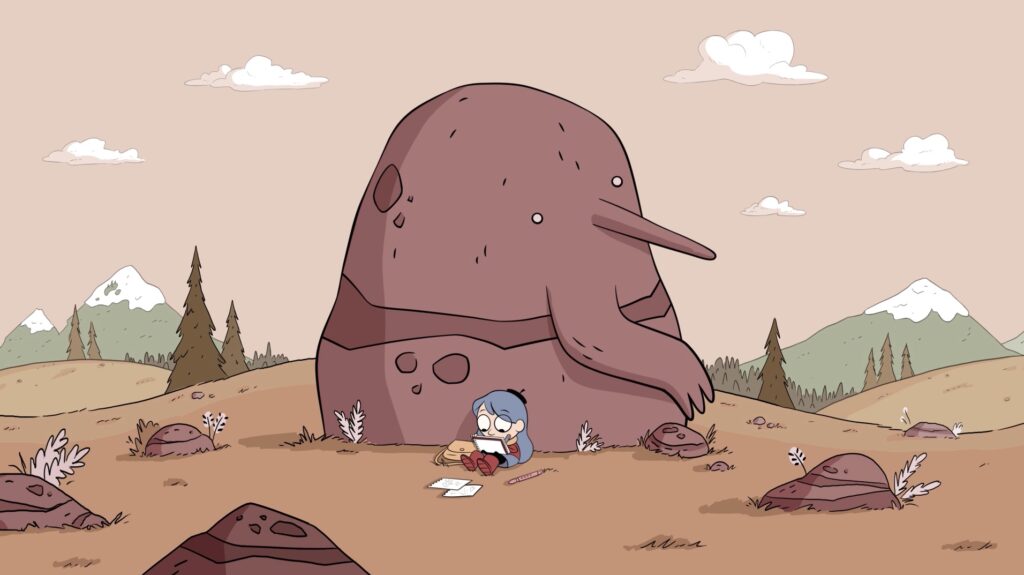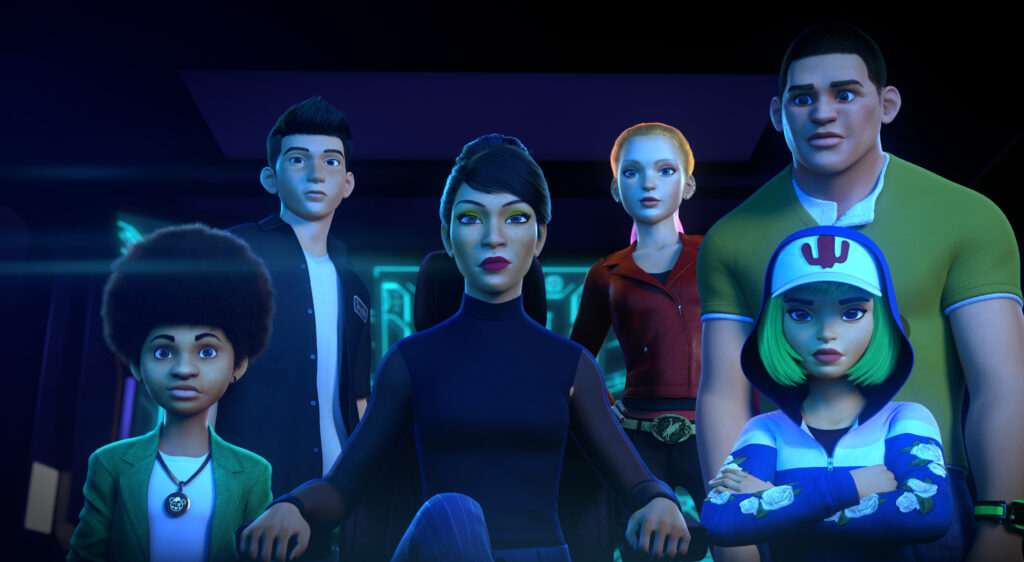
Hilda has a ton of promise as show, although it’s “third season” will be a movie instead, presumably about the fallout from the ending of the second season, which left Hilda in a body-switch scenario with a troll. It’s a pretty fraught storyline in which to end a season, especially after a season in which Hilda and her mother fought and struggled to make bonds or connections that used to come so easily to the two. They were quite the unit at the beginning of season one–the two of them living alone in a cabin in the woods, all filled with wonder and magic and near-infinite space for exploring and adventure. When they had to move to the city (their cabin was destroyed by a giant!), there was a bit of mother-daughter conflict, mostly due to Hilda’s prickly response to city-living and friend-making. But Hilda’s mom quickly showed her daughter that not only did the city possess a huge number of opportunities for adventure on its own, but that she herself knew her away around them. It was the show’s small but notable way of showcasing a strong parent-sibling bond in the face of the kind of craziness that could break them–and, by avoiding the trope of parents being unfamiliar with or ignorant of the weirdness around them, pulls its adult characters into the delightfully audacious imaginations of their children: everyone is apart of this world and has to deal with its antics equally.
So it was kind of a shock when Hilda began to exhibit alienating, and even hostile, anger at her mother throughout season two. It seemed quite a strong counter to the connection they held in season one. There’s a very specific, narrow thread to Hilda’s determined stubbornness, which can be frustrating to other people not quite attuned to it (this, in fact, causes a big blow up between her and Frieda in season one, a conflict that might require two or more watches to get.) But after watching all of season one and seeing how Hilda’s mom seemed totally on board with Hilda’s behavior, and how Hilda’s respect for her mom was so ingrained, watching her suddenly show flashes of attitude at her mom seemed so sudden and… weird. The show tried to thread this shift in Hilda’s demeanor by giving her a deep seated anxiety that had her worried that she was becoming too “naughty” with all of her antics. But it makes little sense. Season two Hilda wasn’t more or less “bad” than season one Hilda, and, again, her voracious outgoing energy has been, time and again, embraced by her mom (give or take the general concern/love/desire for safety that’s normal for any parent.)
There is, arguably, a dramatic, emotionally-rich narrative in which a young but maturing girl starts to question their status under her parent’s roof, that the hormonal and emotional changes that come with puberty and growing up might trigger confused, conflicting reactions to the rules and structure that, not long before, was accepted and tolerated. Hilda suddenly bristling at her mother’s… everything could have worked if Hilda’s encounters began to trigger new, confusing feelings within her. Maybe the moody, ghost-esque teens suddenly begin to look more appealing, or there’s a cute boy (or girl) that slowly begins to catch Hilda’s fancy. There is a potential maturation tale in which Hilda dabbles with witchcraft–although that’s mainly with Frieda, the career-defining vibe to this particular story suggests falling into an adventure-filled “job” that Hilda may want tackle sans parental helicoptering. But we never get that, not even in the narrow, nuanced ways in which Hilda usually functions (the only clue we get is a new, slightly weird post-credits song that “Hilda” sings about her struggles with her stubbornness, which kind of feels weird and desperate, a last-minute Hail Mary method to clarify Hilda’s new emotional responses since that never really happens in-show). Hilda thrives with potential, and that new struggle with her mom could have been as complex and well-handled as Steven’s post-war trauma in Steven Universe Future. But it was never meant to be; perhaps the next movie can put in the tricky, ret-con-y work to plug those daughter/mother dilemmas.

One thing I like about Fast And Furious: Spy Racers? It’s efficiency. Every season is eight ridiculous but snappy episodes that roll in, do their thing, and roll out. There’s no real commitment to the cast, theme, or story here–just fast vehicles doing crazy stunts. The jokes are dumb and forced, but everything moves at such a fast pace that nothing really sticks around long enough to be bothersome, save for a few exceptions (one second season villain, a bad parody of a Real Housewife/Instagram influencer, wears out her welcome upon returning in the third season; the Sahara season is boring because, well, racing in deserts is boring, and it drags pretty heavily).
It, and its “spiritual” counterpart, Jurassic World Camp Cretaceous, both star groups of kids in scenarios that shouldn’t star groups of kids. But both have just enough winking energy to let it roll off your shoulder. Camp Cretaceous is a lot more “grounded” than Spy Racers, in that those kids are way more defined and “realistic,” and have a much more tighter familial connection than Spy Racers hilariously throw-way “we’re family” vomit. But neither is particularly necessary; if your kids like cars and/or dinosaurs, then they’re gonna watch them. Still, shows like these are worth at least exploring once, I think, because of their efficient, workman-like approach to knocking out a season of action, drama, interpersonal conflicts, and broad, cheesy humor. At their peak, both shows can provide an episode that fires on all yeoman cylinders, a thrilling 22-minutes that almost, almost, capture that respective franchise’s best, most enjoyable moments. For Spy Racers, it’s an absurd chase between a submarine and a jet bent on destroying said sub. For Camp Cretaceous, it’s a dinosaur/kids chase within tight quarters and rickety elevators, echoing the high thrills of the OG Jurassic Park. These moments are rare and perhaps not worth wadding through so many seasons of off/on entertainment, but it shows that there’s value in shows that “do the work”.
Spy Racers thrives on bombast and nonsensical cutting edge tech, which works better than some of the stunts that the show comes up with–despite being animated, and thus able to fudge the physical possibilities of vehicular assault more than its live-action counterpart, a lot of the car action is rather bland. Because the show operates at eleven and goes from there, it’s impossible to really come up with something truly visually exciting, since… all of it is, really. And yeah, the characters are broadly drawn and too ridiculous to really engage with them. Which means that they’re perfect for everything the show is putting down. Camp Cretaceous, on the other hand, sinks its teeth into its characters, which is impressive, but arguably can go too far in this direction as well. Mining these characters for layers of nuance to otherwise create more interpersonal conflict is fine, but two characters’ choices in that show’s most recent season bordered on flat-out stupid. (Three episodes are spent dramatically hyping up one kid’s fervent desire to live on the brutal dinosaur island, only for him to obviously change his mind in an instant; one kid sudden sullen attitude towards another kid and his questionable but effective plan comes out of nowhere). Workman animated shows can be good for bumps of audio-visual sensory pleasure, but they tend to lose steam in the long run, whether trying to find more heart-pounding stunts, or scratching at the bottom of the character barrel to contrive yet another fight between characters who, by now, ought to know better. (Spy Racers just dropped its fifth season; I can’t see them going beyond seven.)
I know I said I was gonna do Looney Tunes today as well, but I’ll have to save that for later, as an emergency writing project jumped in my lap. I’m going to be away for Labor Day weekend, so I probably will tackle that show, as well as I Heart Arlo, by September 13th. I also want to discuss the… “scourge” of the generic adult animated show. (I’m a patient man who always tries to let cartoons be the way they are, but even I’ve been growing weary of the “look” of them.)

